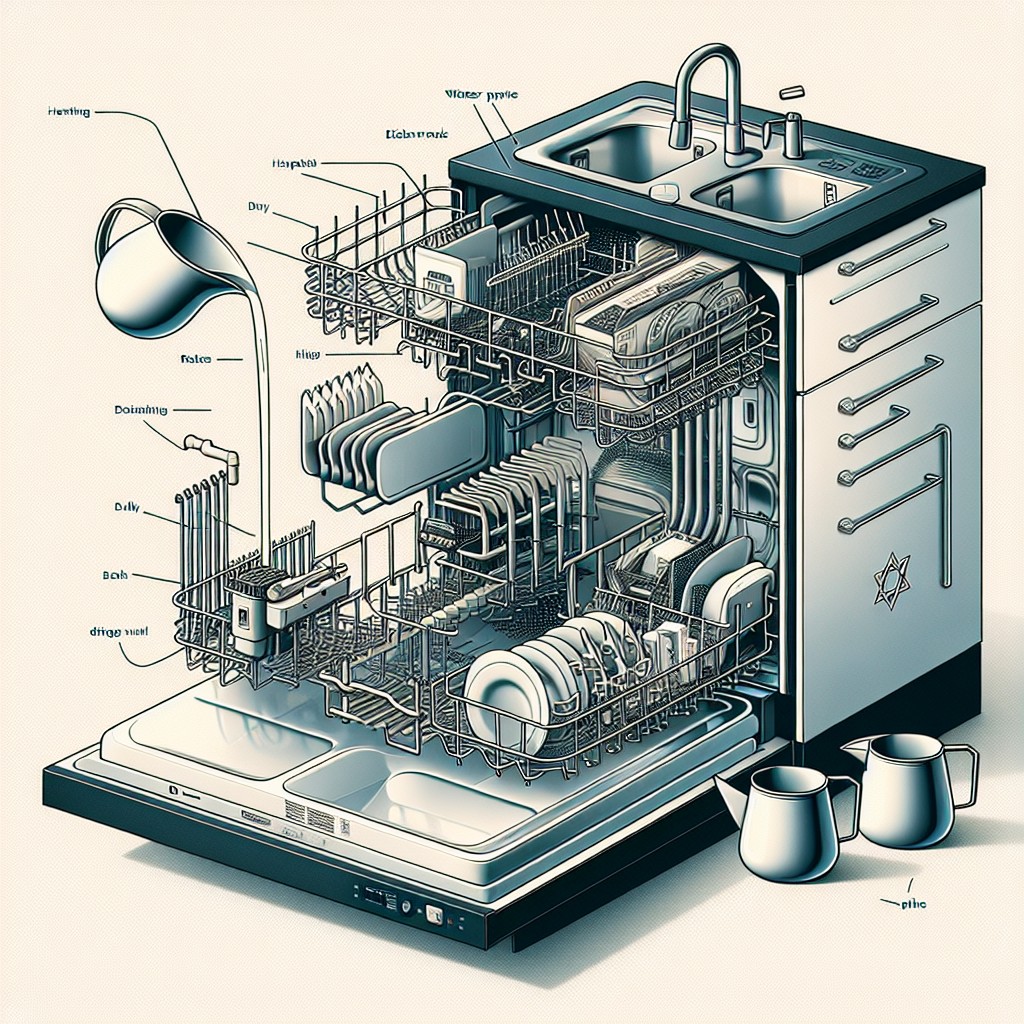Last updated on
Dive into the world of kasher dishwashers because exploring these ingenious ideas can revolutionize your kitchen experience.
These are my unique design concepts made using design tools. I hope you find them inspiring!
Dishwashers, an undisputed kitchen staple, often bask in monotony when it comes to style and function. Not anymore. It’s time to put a fresh spin on the traditional dishwasher, kasher style. There’s an ocean of ideas out there, each boasting their unique appeal, a quick internet search can vouch for that. However, this piece aims to chart unexplored territory. Together, we’ll venture into a mosaic of fresh, unique, and powerful designs that redefine what a kasher dishwasher can be.
Of course, due reverence will be paid to those good old ideas that never fail — a nod to the classics never hurt anybody. So, strap in and ride along this journey of discovery, and by the end, may you find inspiration that breaks away from the humdrum. Let’s get our creative juices flowing, shall we?
What's Inside
DIY Guide On How to Kasher Your Dishwasher

The first necessity is having a thorough understanding of the kashering process. It begins by ensuring that the dishwasher hasn’t been used for a minimum of 24 hours. This period of inactivity purges residual non-kosher foods.
Next, clean the dishwasher thoroughly, paying attention to corners, filters, and racks where food particles may hide.
Once cleaned, initiate a heated wash with no utensils inside. Careful! For effective Kashering, the water must reach a temperature hot enough to thoroughly purge. Invest in a heat-safe thermometer for accurate measurements.
Moving on, key attention should be paid to racks or other parts made from material other than metal. They may need to be replaced as they are less amenable to kashering. If the dishwasher is dual, each compartment should be kashered separately to maintain kosher integrity.
Remember, written instructions for your specific dishwasher model can provide additional helpful information, so consider checking them out. It may require a bit of effort and time, but the reward of having a kosher dishwasher is well worth the endeavor.
Tips for Maintaining a Kosher Dishwasher Year Round

To keep your dishwasher kosher throughout the year, consider these points:
- Clean Regularly: A simple rinse after each load prevents food accumulations. Stick to a more thorough cleaning every few weeks.
- Use Kosher Detergents: Some cleaning agents contain non-kosher elements. Always opt for kosher-certified products.
- Separate Pots and Pans: It’s vital to avoid mixing meat and dairy items in the same cycle. Set aside different times for each category.
- Pre-Rinse: Before placing items in the dishwasher, thoroughly rinse them. This prevents residual non-kosher food particles from contaminating your utensils.
- Monitor Temperature: Hot water is essential in maintaining a kosher dishwasher. Most rules of Kashrut mandate the temperature to exceed the hand-comfortable level, often labeled as ‘yad soledet bo’.
- Replacement of Parts: Over time, replace dishwasher parts which come in contact with food. This ensures that no non-kosher residue lingers in your machine.
- Check Seals: Ensure tight seals on the appliance door to avoid contamination seeping in.
- Consult Reliable Kashrut Sources: When in doubt, consult reputable Jewish law sources or a Rabbi. Knowledge on Kashrut can range from straightforward to extremely complex. Always reach out when unsure.
Incorporating these steps into your kitchen routine ensures a kosher dishwasher, keeping your home in accordance with Jewish dietary laws.
Small but Efficient Kashered Dishwashers Suitable for Apartments

When you’re tight on space, a compact dishwasher can be a real game changer. But remember, kashering principles remain equally relevant.
1. Size Measurement: Check the kitchen dimensions before selecting a dishwasher. Ensure there’s ample ventilation space around the appliance.
2. Capacity: Look out for dishwashers that maximize internal space. Models with adjustable racks or foldable tines can accomodate larger or irregularly shaped dishes.
3. Noise Level: In a small apartment, a quiet dishwasher is essential. Look for models offering noise reduction technology.
4. Kashering Features: Ideally, a dishwasher with a ‘Sanitize’ setting is required, which reaches high temperatures necessary for kashering.
5. Energy Efficiency: Compact doesn’t have to mean less efficient. Seek out Energy Star rated models which use less water and power.
6. Installation: If you’re renting, consider a portable or countertop model. These can be easily installed and moved when necessary.
Yet, ensure you have a tried-and-true kashering process in place. This way, you can maintain the Kashrut of your kitchen, irrespective of its size.
Innovative Ideas for Designing a Kosher Kitchen With Dishwasher

When integrating a dishwasher into a kosher kitchen, thoughtful design can streamline your daily routine and enhance the functionality of your space.
1. Separate Spaces: If feasible within your floor plan, consider installing two dishwashers to separately clean milk and meat dishes, eliminating risk of cross-contamination.
2. Dishwasher Drawers: For smaller kitchens, dishwasher drawers can be a solution. They are compact, can be installed side by side or separate locations, and allows for independent cycles for dairy and meat utensils.
3. Color Coding: To avoid mix-ups, utilize color-coded racks or knobs on each dishwasher.
4. Location Near Sinks: Situate the dishwasher close to sinks to simplify the process of scraping and rinsing plates before loading.
5. Panel-Ready Models: To remain aesthetically pleasing, use panel-ready models that can be fitted with cabinetry fronts.
6. Visible Timers: Choose models with visible timers or indicator lights, aiding in tracking the status of different loads.
7. Energy-Efficient Models: Saving energy aligns with the Jewish principle of Tikkun Olam, repairing the world, thus energy-efficient dishwashers not only reduce utility bills but also align with faith.
Remember, the goal is to make maintaining Kashrut in your kitchen as effortless as possible, so consider your personal habits and needs while designing.
Understanding the Process of Kashering a Dishwasher: Step By Step

The process of making a dishwasher suitable for kosher use involves several important steps. Initially, all parts of the appliance need a thorough cleaning. This includes racks, utensil holders, and walls. Ensure all food debris and residue are totally removed.
Once the initial cleaning is complete, the dishwasher should be left idle for a minimum of 24 hours. This period of inactivity is key in the kashering process, allowing any absorbed tastes to neutralize.
The final step employs the use of boiling water, also known as hagalah. Run the dishwasher at its highest possible heat setting. This effectively kashers the interior and completes the task.
Remember, the kashering of a dishwasher may have different requirements based on the material it is made of. For instance, stainless steel can be kashered, while porcelain cannot.
How Recent Technological Advancements Are Affecting Kosher Dishwashers

Exciting developments in technology have led to new possibilities for kosher dishwashers. Advanced heating mechanisms are a game changer, as the kashering process requires elevating the appliance to an extreme level of heat, a process known as ‘Libun’. High temperature cleaning cycles now available in some dishwasher models simplify this process.
Next-gen dishwashers are also offering separate compartments with individual water supply, making it possible to wash meat and dairy utensils separately in one cycle. This limits cross contamination, adhering to kosher rules without requiring two distinct appliances and saving consumers cost and space.
Additionally, the advent of Smart dishwashers herald a new era. Integrating technology, such as timing controls and sensors, to manage various settings for different utensils potentially alleviates complications of keeping a dishwasher kosher.
Lastly, improvements in efficiency reduce the usage of electricity and water, aligning with Jewish teachings promoting environmental responsibility. This not only makes kashering process more sustainable, but also results in lower utility bills, providing a win-win situation for consumers.
Remember, while these features facilitate maintaining a kosher dishwasher, they do not replace the traditional kashering procedures.
Energy-Efficient Kosher Dishwashers: A Buying Guide

When choosing an energy-efficient, kosher-friendly dishwasher, consider the following aspects to ensure it meets your requirements without compromising on Kashrut principles:
1. Energy Star Rating: This signifies that the dishwasher uses less energy, therefore, reducing the cost of operation.
2. Delay Start Feature: Allows setting the dishwasher to start at a predetermined time, which not only saves energy, but also adheres to Shabbat observance rules.
3. Soil Sensor: This feature adjusts the duration of the wash cycle, depending on how dirty the dishes are, conserving energy and water.
4. High-Temperature Option: Important for the effective cleaning of meat and dairy utensils, as well as for Kashering the dishwasher.
5. Standby Power: Check if the dishwasher uses power when in standby mode to avoid unnecessary usage.
6. Size: A dishwasher attuned to your typical load size ensures efficient cleaning without wasting water or energy.
Remember, while the investment price might be higher for energy-efficient, kosher-friendly dishwashers, over time they offset the cost through savings on utility bills. Choose wisely to harmonize with your kosher lifestyle while promoting sustainable living.
The Importance of Dishwasher Kashrut in Maintaining a Kosher Home

In a kosher home, ensuring the cleanliness of utensils, appliances, and dishwashers adheres to prescribed Jewish dietary laws. It’s not only about physical cleanliness but also spiritual purity.
1. Prevents Mixing of Dairy and Meat: The separate washing avoids cross-contamination, barring the blending of dairy and meat elements, one of the key tenets of keeping kosher.
2. Maintains Spiritual Purity: Abiding by kashrut laws goes beyond hygiene, it is a spiritual commitment involving every bit of kitchen elements, including dishwashers.
3. Passover Preparation: Kashering the dishwasher ensures the removal of chametz (leavened products), ready for Passover.
4. Assures Holiday Readiness: Jewish holidays often have specific dietary rules. A dishware cleaning routine adapted to these rules keeps your kitchen holiday-ready.
5. Ensures Compliance with Jewish Law: Above all, keeping the dishwasher kosher ensures compliance with Jewish dietary law, fostering a positive spiritual environment in the home.
Maintaining a kosher dishwasher is a small yet significant step in upholding the kashrut essence, facilitating a comprehensive kosher lifestyle.
How to Kasher an Old Dishwasher: Things You’ll Need and Steps to Follow

For kashering an old dishwasher, gather essential supplies: boiling water, a natural cleaning solution, oven mitts, and a soft scrub brush.
Begin by thoroughly cleaning the inside, paying close attention to the corners, seals, racks, and the dishwasher filter.
Once every nook and cranny is spotless, initiate the kashering process.
Fill the dishwasher with dishes and utensils permissible for kashering, then run the machine on its hottest setting.
It’s crucial to remember, kashering won’t work correctly when the dishwasher is run empty.
A point worth noting is the significance of heat during kashering.
The temperature is key to paving the way for a kosher dishwasher.
The scorching water essentially acts to ‘purge’ the remnants of past ‘treif,’ or non-kosher meals, effectively kashering your appliance.
Remember, after kashering, maintain the dishwasher’s kosher status by avoiding non-kosher dishes and running separate cycles for meat and dairy items if not using two different dishwashers.
By following these simple steps, you’ll successfully kasher an old dishwasher.
Top Brand Reviews: Which Dishwashers Are Easiest to Kasher?

Whirlpool, Bosch, and Samsung top the list when it comes to dishwashers that are relatively easier to kasher.
1. Whirlpool: Known for its simple yet effective design, Whirlpool dishwashers have easily removable parts, allowing for thorough cleaning, a key requirement for a successful kashering process.
2. Bosch: Its precise water heating mechanism makes it easier to reach the necessary temperature for koshering. Bosch models are a good choice for those seeking a seamless kashering process.
3. Samsung: Samsung’s dishwashers stand out for their efficient water jets, covering all corners of the device. This feature, along with its self-cleaning technology, makes the kashering process more straightforward.
Keep in mind that while these brands provide certain handy features that simplify the kashering process, all dishwashers can be made kosher following the appropriate steps. It’s essential to understand the necessary procedures and requirements regardless of the chosen brand.
Kashering for Passover: Making Your Dishwasher Pesach-Ready

When Pesach comes around, take into account some important steps to properly prepare your dishwasher. Firstly, refrain from using the appliance for a period of 24 hours. This gives time for any remaining traces of food to be considered null. Following this period, ensure the dishwasher is thoroughly cleaned, removing any pieces of leftover food stuck in the filter, jets or anywhere else.
In the next stage, run the dishwasher on the highest heat setting. It’s recommended to do this with a Kosher-for-Passover dishwasher detergent. With these steps complete, your dishwasher should be Pesach-ready.
Keep in mind that during Passover, separate the washing of meat and dairy dishes, with an appropriate waiting period and an extra rinse cycle between. Always consult your rabbinical authority if you’re unsure about any steps in this process.
Spotless Kashering: Removing Even the Toughest Chametz From Your Dishwasher

To fully remove stubborn Chametz residue, start by thoroughly cleaning the dishwasher. Use a cleaning solution made of warm water and a dishwasher-safe detergent. Pay attention to corners, filters, and other overlooked areas.
Next, let the dishwasher sit unused for a minimum of 24 hours. This wait time is crucial as it allows any invisible Chametz to become completely “nullified”.
The third step involves running the dishwasher at its highest heat setting. The combination of the wait period and running the appliance at a high temperature ensures proper Kashering.
Lastly, it’s always wise to consult a local rabbi for specific procedures in line with halachic laws. They can provide valuable guidance to make the process seamless.
Remember these practices need to be repeated each year for Passover as per Jewish law. Regular maintenance is also beneficial to keeping a kosher kitchen beyond Passover.
Lastly, use of a dishwasher basket or a mini dishwasher specifically for Pesach can help. These are particularly useful when dealing with items that cannot withstand the heat needed for Kashering.
Pros and Cons: Should You Buy a Separate Dishwasher for Meat and Dairy?

Opting for two dishwashers, one for meat and one for dairy, can simplify your kosher kitchen. No need to kasher in between uses, fewer worries about mixing utensils, and changes in dietary habits are managed with ease.
However, this convenience comes at a cost. Separate dishwashers mean a higher initial investment, increased energy bills, and the need for additional space to accommodate two units. It’s also important to remember, even with two dishwashers, careful attention to utensil sorting is still essential to maintain kosher standards.
Various factors including budget, kitchen size, and personal preference will ultimately guide your decision in this matter.
Top Resources to Understand and Perform Dishwasher Kashering

Diving into various resources can be incredibly helpful in mastering the art of dishwasher kashering.
1. Rabbinical Teachings and Texts: Rabbi’s lectures or Torah study sessions often encompass this topic and help gain a scholarly perspective on how to maintain a kosher kitchen.
2. Jewish Community Centers: Many organize workshops or demonstrations on Kashrut practices including dishwasher kashering.
3. Kosher Certification Agencies: Their websites contain detailed guidelines on Kashrut observance. OU Kosher, Star-K, and OK Kosher are considered reliable.
4. Online Forums and Blogs: Websites like Chabad.org offer a plethora of articles, how-to guides, and expert advice on the subject. Platforms like Quora have discussions amongst members of the Jewish community where practical tips can be procured.
5. YouTube Tutorials: They give visual step-by-step instructions and make the process easy to follow.
6. Jewish Cookbooks: Many have sections dedicated to kosher kitchen rules and can provide traditional and practical insights.
7. Local Synagogue: It can be helpful to consult the local Rabbi or fellow congregants for advice relevant to one’s specific community and practice.
By leveraging these resources, you can ensure your dishwasher is kashered correctly and efficiently.
Marina’s Kitchen Hacks: Making Kashering Your Dishwasher a Breeze

While Marina empowers you with hacks to simplify the kashering process, it’s important to remember a few guiding principles.
1. Clean First: Keep the interiors, racks, sides, all nooks and crannies debris-free. A clean dishwasher is easier to kasher.
2. The 24-Hour Rule: The dishwasher should remain unused for at least 24 hours before kashering. This ensures that any residual tastes from processed dishes are nullified.
3. High Heat: Run the dishwasher empty on the highest heat setting possible. The heat works its magic by koshering the dishwasher.
4. Add Boiling Water: Add another level of koshering by pouring boiling water on racks and the dishwasher’s walls.
Remember, these are not just hacks. They are well-identified methods often bypassed in common conversation, yet crucial to achieving a kosher kitchen. Marina’s hacks are about refining the process to avoid unnecessary complexity and still achieving thorough kashering.
Global Trends in Kosher Dishwashers: What the Future Holds

As global kitchens evolve, innovations are redefining kosher appliances. Dishwashers aren’t left behind in this advancing tide.
The rise of smart technology has led to streamlined kosher-friendly designs. These dishwashers come with dual functionality allowing separate cleansing for meat and dairy dishes. Quick-heating features reach the high temperatures required for kosher preparation faster than ever.
The use of artificial intelligence also hints at future possibilities. We can anticipate dishwashers with pre-programmed settings for specific kosher cleaning sequences—Pareve, Dairy, and Meat—facilitating stress-free kashering.
More manufacturers are also participating in the ‘eco-friendly’ trend, introducing energy-efficient models that not only lower electricity bills but align with environmental stewardship. Lastly, compact design offers promise for those kitchen spaces at a premium, providing efficient use without sacrificing kosher requirements.
In this ever-changing landscape, staying informed about these trends ensures your kitchen remains both kosher and contemporary.
Cost-Efficient Ways to Kasher Your Dishwasher: Saving Time and Money

Rather than purchasing new appliances, add value to your existing ones. An efficient way to do this revolves around the application of heat. Heat your dishwasher to the highest temperature possible, usually the “Sanitize” setting, and run it empty. This renders it kosher as the high heat effectively purges it of any residual non-kosher particles.
Another savvy method involves not mixing dishes. By reserving your dishwasher for either dairy or meat, you maintain its kosher status without extra measures. Additionally, buy dishwasher-safe items that are easy to kasher, like metal or glass utensils.
Lastly, ensure regular cleaning, focusing on filters. A clean dishwasher means less residual food bits, thus less risk of non-kosher contamination. Pushing out the need for frequent kashering, this trick is a real money saver. Keep in mind, professional kits exist for thorough cleaning. Making it a DIY task is well within reach, saving you even more.
By following these practices, you can keep your kitchen kosher compliant while saving time, effort, and your budget.
Kasher Dishwasher Techniques: A Comparative Study

There are primarily two techniques that are popular in koshering dishwashers – the boil-over and the 24-hour abstinence methods.
The boil-over technique involves running an empty dishwasher at its highest temperature setting. Some also recommend placing a pot of boiling water in the bottom during the run. This approach utilizes the steam created by the high temperatures to kasher the dishwasher.
The 24-hour abstinence method requires not using the dishwasher for a full day and then running it empty on its highest heat setting. It is based on the Talmudic ruling that the taste of non-kosher food absorbed in a utensil becomes nullified after 24 hours.
Choosing between the two depends on personal preferences, time constraints, and the specific requirements and capabilities of your dishwasher. The 24-hour method is seen as more lenient and easier to accomplish, but the boil-over technique is viewed by some as more efficient.
Each dishwasher may also have unique parts that require different treatment. Check the user manual and consult with knowledgeable authorities to determine the best approach for your specific appliance.
Remember, the objective of the process remains the same – to draw out and nullify any non-kosher absorption in the dishwasher using heat.
The Role of Temperature in Kashering a Dishwasher: An In-depth Look

Diving straight into the topic, high temperature is key in Kashering a dishwasher. You might wonder why? The principle behind it is essentially the concept of “K’Bolo Kach Polto” in Jewish law, which roughly translates to “as it absorbs, so it expels”.
1. This principle denotes that the way a dishwasher absorbs non-kosher food particles is the same way it should expel them, meaning through heat.
2. Kashering requires a substantive heat source. In dishwashers, this is usually achieved by running it empty on the highest heat setting.
3. The hot water and steam must reach a temperature of at least 190°F to 200°F—approximately the temperature at which food particles are absorbed into the dishwasher walls.
4. The increased temperature ensures effective expulsion of absorbed substances, restoring the dishwasher’s kosher status.
Remember, each dishwasher’s heat level can vary, so refer to your user’s manual to set temperatures accurately.
Ideas Elsewhere
- https://koshernexus.org/2011/03/kashering-your-dishwasher-for-pesach/
- https://oukosher.org/passover/webcast/pre-pesach/how-to-kasher-dishwasher/
- https://learn.oheltorah.com/t/kashering-a-dishwasher-for-pesach/7393
- https://www.torahmusings.com/2014/01/dishwashers-and-kashrut/
- https://dinonline.org/2011/06/29/kashering-refrigerator-stove-and-dishwasher/
Continue reading:



